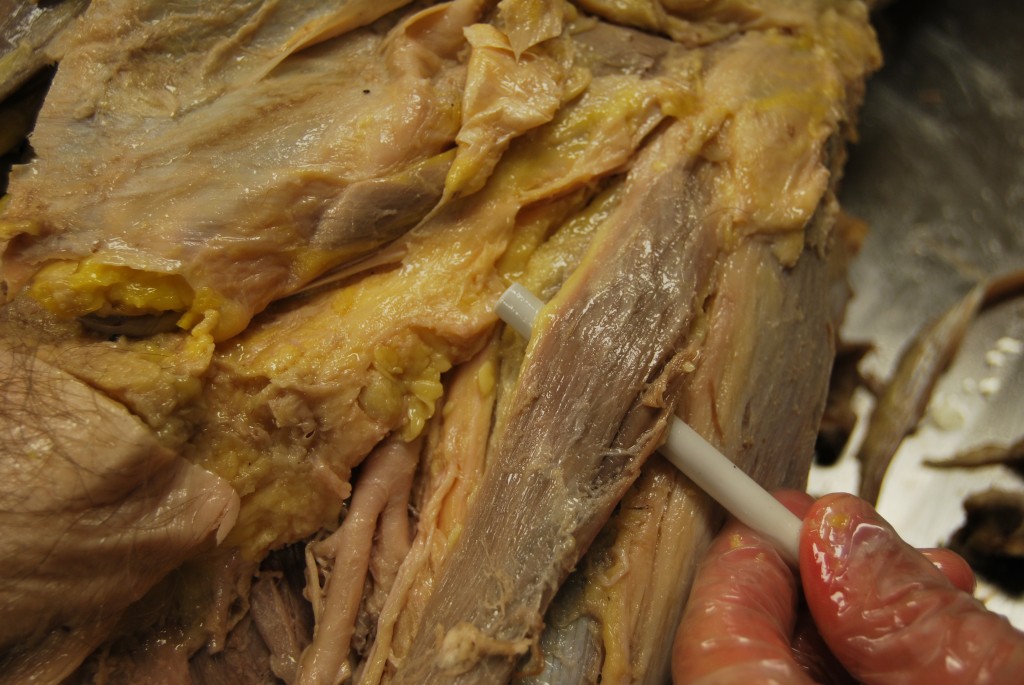Fascia Iliaca Tips #2
THE SPREAD
Usually, the Fascia Iliaca and Fascia Lata are clearly identifiable next to the thinner and less echogenic muscle fibers of the Sartorius and Iliopsoas muscles. There are times, however, when the deeper border of the Sartorius muscle blends in well or the exact position of the tip of your needle is difficult to identify. As there are no nerves that you are trying to stimulate as an endpoint with this nerve block, you must rely on ‘feel’, your understanding of sonoanatomy and clues that you can find in the ultrasound picture. Here are a few tips to confirm that you are injecting in the right place during your Fascia Iliaca nerve block.
I mentioned in the FASCIA ILIACA section that the local should spread in a cranial direction. It should be incredibly easy to inject and track in a thick black line without muscle stranding after initially expanding the space next to the needle tip. If the ‘bulge’ of local anesthetic spread stays localized, you are within a muscle belly. That should be an obvious observation. If, however, you see the local spread in a linear pattern, but it is heading toward the feet, you are still in the wrong place. Let me expand on what is going on here how to fix this problem. First, take a look at the cadaver picture below.
[nonmember]…
REGISTER for FREE to become a SUBSCRIBER or LOGIN HERE to see the full article!
[/nonmember]
[wlm_ismember]
To the right is lateral. In this picture, I am identifying the sartorius muscle. If in proper position, your needle should be approaching the iliopsoas muscle medial to and around the level of the origin of the sartorius muscle at the ASIS. Your needle in the above scenario has entered this muscle and is now completely deep to it, but it has not passed through the posterior border of the epimysium (connective tissue that completely surrounds a muscle). . This means you are still above the Fascia Iliaca AND still within the sartorius muscle. Since you are very close to the origin of this long and relatively thin muscle, when you inject your local, it only has the ability to expand in the direction of the muscle body. Whether you meant to traverse the sartorius muscle or not, you must make an adjustment, or you will only be performing a lateral femoral cutaneous nerve block.
When you see local anesthetic flowing toward the feet only, you should advance the needle slightly. You should feel a ‘pop’ (through the epimysium), then, after noting a tenting of the tissue below, you should feel a bigger ‘pop’ (Fascia Iliaca). Now your injection show spread appropriately. If you end up between these ‘pops’ (and between the sartorius and the fascia iliaca), local will still spread up and down, but it is not a ‘free flow’. That is. there is a little more pressure to inject, and the spread is not as dramatic. It is also a pretty thin black line.
If you get to a point where you think you are in this space between fascial planes, just advance your needle a bit further while injecting at a constant amount of pressure. You will either:
1) completely lose spread (it will go into muscle, so you get a bulge and muscle stranding pattern) because you are now within the muscle of the iliopsoas. In this case, just back up ever so slightly. That is, you were already in the right place.
2) push past the fascia iliaca, and spread will dramatically improve. It should inject very easily, create a thick band below your needle and go in a cranial direction.
The other trick to determining where in the world you just injected a few milliliters of local anesthetic is to look at it from a different angle. Keep your needle exactly where you have it -which is easy if your hands are secured properly. Rotate the probe to a transverse orientation (90 degrees), and see where the local anesthetic has gone. It will ‘layer out’ within the sartorius muscle, below it or under the fascia iliaca unless you created a deposit within a muscle belly. Even if you put it in a muscle belly, you know where you are now, so you can now make the appropriate adjustment. It takes a little more dexterity and the ability to find your needle again, but moving the probe to a typical transverse view of the femoral nerve it a great confirmation of spread. It will probably require a little more injection of local than the previous trick to really begin to see the spread near the femoral nerve. You may fall into a trap if you make multiple injections before rotating your probe to see where your needle is since you may not know which puddle you are in at present. A tiny bit of local at the back of the sartorius muscle can appear to be a lot in transverse view. Sliding the probe up and down the length of your needle may allow you to track the needle ‘dot’ (as it appears out-of-plane ) which may help if you have made multiple injections at various locations. Continuing to inject (wherever you are) may reveal an increase in volume of your present location if you think you are in the right place and can afford losing local to the wrong place if you are wrong. Work at these tips for now. I will add another entry soon about using air to your advantage in this and other situations.
The video below demonstrates an inaccurate spread pattern followed by the appropriate spread pattern.
[/wlm_ismember]


